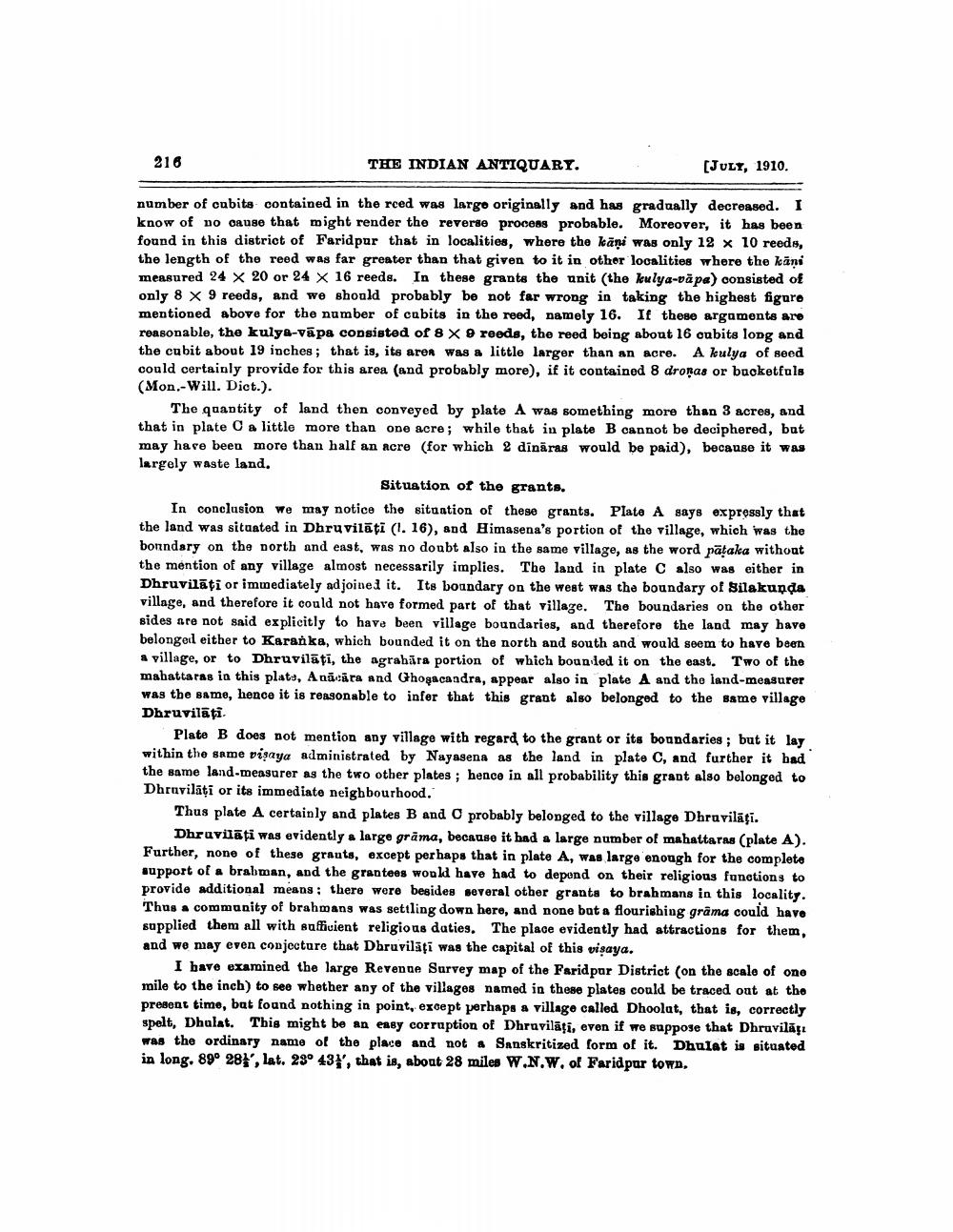________________
216
THE INDIAN ANTIQUARY.
(JULY, 1910.
number of cubits contained in the reed was large originally and has gradually decreased. I know of no cause that might render the reverse process probable. Moreover, it has been found in this district of Faridpur that in localities, where the kāņi was only 12 x 10 reeds, the length of the rood was far greater than that given to it in other looalities where the käni measured 24 X 20 or 24 X 16 reeds. In these grants the unit (the kulya-väpa) consisted of only 8 X 9 reeds, and we should probably be not far wrong in taking the highest figure mentioned above for the number of cubits in the read, namely 16. If these argaments are reasonable, the kulya-vāpa consisted of 8 X 9 reeds, the reed being about 16 cubits long and the cubit about 19 inches; that is, its arer was a little larger than an acre. A kulya of seed could certainly provide for this area (and probably more), if it containod 8 droņas or bucketfuls (Mon-Will. Dict.).
The quantity of land then conveyed by plate A was something more than 3 acres, and that in plate C a little more than one acre; while that in plate B cannot be deciphered, but may have been more than half an acre (for which 2 dinaras would be paid), because it was largely waste land.
Situation of the grants. In conclusion we may notice the situation of these grants. Plate A says expressly that the land was situated in Dhru vilāti (1. 16), and Himasena's portion of the village, which was the bonndary on the north and east, was no doubt also in the same village, as the word pātaka without the mention of any village almost necessarily implies. The land in plate also was either in Dhruvilāti or immediately adjoined it. Its boundary on the west was the boundary of Silakunda village, and therefore it could not have formed part of that village. The boundaries on the other sides are not said explicitly to have been village boundaries, and therefore the land may have belongoil either to Karanka, which bounded it on the north and south and would seem to have been a village, or to Dhruvilāti, the agrahāra portion of which bounded it on the east. Two of the mahattaras in this plats, Anātāra and Ghoşacaadra, appear also in plate A and the land-measurer was the same, hence it is reasonable to infer that this grant also belonged to the same village Dhruvilāti.
Plate B does not mention any village with regard to the grant or its boundaries; but it lay within the same visaya administrated by Nayasena as the land in plate C, and further it bad the same land-measurer as the two other plates; hence in all probability this grant also belonged to Dhruvilāți or its immediate neighbourhood.
Thus plate A certainly and plates B and probably belonged to the village Dhruvilāci.
Dhruvilāti was evidently a large grama, because it had a large number of mahattaras (plate A). Further, none of these grauts, except perhaps that in plate A, was large enough for the complete support of a brabman, and the grantees would have had to depend on their religious functions to provide additional means; there were besides several other grants to brahmans in this locality. Thas a community of brahmans was settling down here, and none but a flourishing grama could have supplied them all with sufficient religious daties. The place evidently had attractions for them, and wo may even conjecture that Dhruvilāti was the capital of this visaya.
I have examined the large Revenge Survey map of the Faridpur District (on the scale of one mile to the inch) to see whether any of the villages named in these plates could be traced out at the present time, but found nothing in point, except perhaps a village called Dhoolat, that is, correctly spelt, Dhulat. This might be an easy corruption of Dhruvilāți, even if we suppose that Dhruvilāçı was the ordinary name of the place and not & Sanskritized form of it. Dhulat is situated in long. 89° 28', lat. 29° 43', that is, about 28 miles W.N.W. of Faridpur town,




